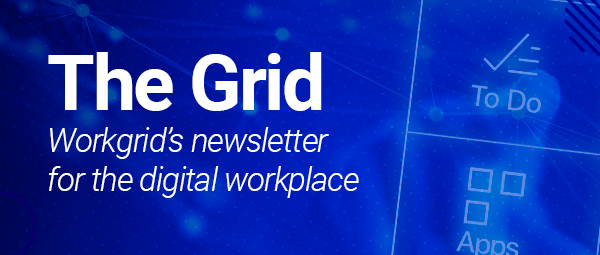Solving the challenges of the digital workplace
If there’s one silver lining to the pandemic, it’s that it’s trained a bright spotlight on the realities of the work experience for employees. What we’ve learned about the day-to-day experience of the digital workplace has been eye opening. Employees are in desperate need of help. They’re overwhelmed, drowning in information, overrun with applications, and frustrated by the digital friction that keeps them from spending time on more meaningful work.
![[asset] digital-assistant-stock-photo](https://images.ctfassets.net/z7p73u8c0thn/5dfmwWLmYbdDKCcMRIaV2m/308278d47704a135448f39c4a006ea4b/digital-assistant-stock-photo.jpg?w=1200&h=752&fl=progressive&q=60&fm=jpg&bg=transparent)
Employees spend, on average, at least two hours a day (25% of their work week) looking for the documents, information or people they need to do their jobs.” (Source: Human Resource Director)
Thankfully, understanding that this is a problem is the first step to fixing it. And there are ways to fix it - to help employees work smarter, not harder and eliminate the roadblocks that prevent them from being productive and fulfilled. One way is by implementing a digital assistant.
Digital assistants are designed to free users from spending time on routine functions that don’t require human intervention. In our personal lives we might use a digital assistant to find a nearby coffee shop, check the weather, or reorder household staples. In the workplace, digital assistants provide a whole different level of utility, helping employees find important information and handle requests like processing approvals, submitting, and tracking service desk tickets, etc.
The benefits of using a digital assistant are vast, and there are some compelling reasons your employees need one. Here are some now….
1. Improving attention management
By abstracting contextually relevant aspects of enterprise systems, digital assistants present the tasks and information employees need in a single experience that’s within the flow of work.
![[gif] workgrid-functionality](http://images.ctfassets.net/z7p73u8c0thn/38BtHgXbdurZboeVLcyZmr/bb062bae3b111e94f06374f8b156207a/Workgrid_Functionality.gif)
2. Reducing digital friction
By consolidating what’s important into a single experience, digital assistants make it easy for employees to find important information from enterprise systems - such as pay data, time-off balances, dashboards, and more - without having to log into individual source systems.
3. Streamlining and personalizing communications
Digital assistants use existing employee data, such a job role, function, and location to deliver contextual alerts that are relevant to employees, like training and upskilling opportunities, office closures, staffing changes, inventory changes, and crisis communications.
4. Delivering fast, personalized answers to common questions
Chatbot functionality, a common feature within most digital assistants, provides round-the-clock responses to employees’ questions, eliminating the need to wait for human assistance.
![[gif] ITSM Help Desk Ticket Chatbot](http://images.ctfassets.net/z7p73u8c0thn/52t4yOfEN85FT5ITtOBBot/b46ac6a93796ce700ca4aacb53300343/GA_September_ITSM.gif)
5. Supporting the autonomy of employees
Enterprise digital assistants can be customized to enable self-service functionality, giving employees the flexibility to complete routine tasks like submitting and tracking help desk tickets, wherever and whenever it’s convenient for them.
6. Streamlining complex, common processes
As part of creating a centralized experience for important tasks and information, digital assistants also generally provide task and workflow functionality that simplifies complex processes requiring collaboration across the enterprise, such as onboarding, training, performance management, etc.
7. Promoting workplace agility
Because digital assistants are available wherever employees work, whether on the intranet, via mobile, or in workstream collaboration platforms such as Slack and MS Teams, employees can have the flexibility they need to work as and when it’s convenient for them.
![[asset] Workgrid for Teams mobile wide](https://images.ctfassets.net/z7p73u8c0thn/5lSwxrccKxeIyMrfTDoatV/ec9fbdda9dae004cb249c8116033b475/MS_Teams_Channels.png?w=1200&h=675&q=60&fm=png&bg=transparent)
8. Creating experience parity
Because digital assistants are available in a variety of formats and channels, they create a consistent experience between office-based and frontline workers, delivering the same access to tasks and information for all employees.
9. Facilitating better decision-making
By making it faster and easier to find reliable information, digital assistants help employees make more informed decisions that drive business results.
10. Standardizing the employee experience
Enterprise digital assistants are invaluable tools in cases like mergers and acquisitions because they can integrate with disparate systems across the enterprise to deliver consistent, yet custom, experiences to all employees.
11. Modernizing intranet or employee portal
Digital assistants make effective use of integrations to bring the power of enterprise applications directly to the intranet, enabling employees to carry out tasks and find essential company info from a single experience.
![[asset] Intranet To Knows and To Dos Workgrid Example](https://images.ctfassets.net/z7p73u8c0thn/7Kq2fmsFU2bDJBKBH1Tjz5/8b5ab3179b2ed46272aa9ff0b283245e/AES_Toknows_ToDos.jpg?w=1200&h=821&fl=progressive&q=60&fm=jpg&bg=transparent)




